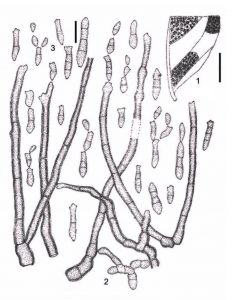Cladosporium hippocrateae H.D. Bhartiya, N. Kumari, Sham. Kumar & R. Singh, sp. nov., Index Fungorum number: 811698
Etymology: Specific epithet hippocrateae derived from the host plant genus.
Infection spots amphigenous, sub-circular to irregular, later coalescing to form large patches, blackish. Colonies amphiphyllous, effuse, greyish white. Mycelium external, hyphae branched, septate. Sexual morph: Not observed. Asexual morph: Stromata absent. Conidiophores arising from external hyphae, single or caespitose, macronematous, mononematous, branched, smooth-walled, 0–8 septate, erect, straight or flexuous, curved, swollen, light olivaceous to olivaceous-brown, 135–335 × 3.5–6.5 µm. Conidiogenous cells integrated, terminal or intercalary, polyblastic, sympodial, cicatrized, bearing thickened conidial scars. Conidia 6.5–34 × 4.5–6.5 µm, dry, holoblastic, acropleurogenous, cylindrical, variable in shape and size, ellipsoidal or oval, 0–5 transversely septate, smooth-walled, apex sub-acute to obtuse, base obconico-truncate to rounded, light olivaceous, hila distinctly thickened, small but clearly protuberant.
Known distribution: India.
Material examined: INDIA, Uttar Pradesh, Deoria, on living leaves of Hippocratea arborea Roxb. (Celastraceae), 5 December 1997, Nisha Kumari, HCIO 43144 (holotype), GPU Herb No. 8524 (isotype).
Fig. 1 Cladosporium hippocrateae (HCIO 43144). 1 Infection spots. 2 Conidiophores. 3 Conidia. Scale bars 1 = 20 mm. 2, 3 = 20 µm.

